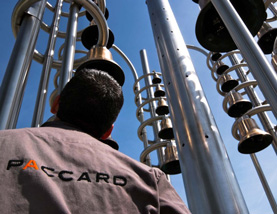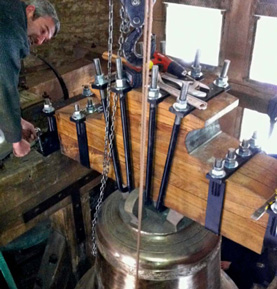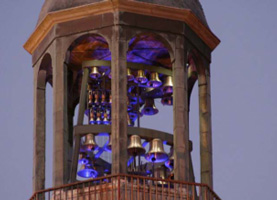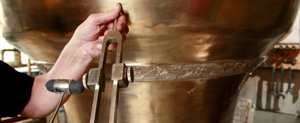|
Paccard today
|
|
The entry into the third millennium
|
Currently, the foundry is run by Philippe, assisted by his brother Cyril. The sons of Pierre represent the seventh generation PACCARD: with them, the company is entering the third millennium.
After moving the company to Sevrier (on Annecy Lake), in 1989, the two brothers have faced many challenges: the chimes of Chambéry (largest carillon in Europe), the Peace Bell (33 tons), but also the creation of two new entities: Campanuna, only global sales website online custom bells and Ars Sonora, town planning concept combining musical bells to sculpture and architectural design.
New workshops help meet strong demand. Each year, hundreds of bells out workshops, 70% for export.
In total, since the first bell Quintal, more than 120,000 bells have left the workshops of the foundry PACCARD for the most varied destinations: New York, Tokyo, Montreal, Paris, Douai, Dallas, Washington, Berkeley, Seychelles Islands
|
 |
|
 |
|
Many jobs related to the world of the bell
|
 |
The area of expertise is wide:
• Foundry bells
• Campaniste (maintenance of towers, clocks, ...)
• Chime Carillon
• Art Foundry
• Musicale Sculptures
• Online sales
• Casts on site
"The originality of our company is having in its history, some engineers who are interested, beyond the bell itself, how to make it sound. Today PACCARD designs its systems order to automate the ringing of bells. "Cyril Paccard, Director, Office Studies
|
|
 |
|
The Stradivarius Bell
|
Two centuries of history and a track record of more than 120,000 bells foundry PACCARD allowed to rise to the rank of # 1 World bells chime. Such a reputation is not a coincidence. It is based on three fundamental characteristics: the quality of the profile, the choice of metal and precision tuning.
The bell is a real musical instrument. To vibrate, she heard a main sound - called Basic - and secondary sounds appointed Harmonics - Um, Minor third Quinte Octave top - perfectly measurable.
The intensity and variety of these harmonics are the stamp for each instrument. However, the bell has a particul featurey: the third harmonic is slightly decreased, making it a minor third. This is the minor third, which gives the bell its peculiar stamp, a little melancholy
|
 |
|
 |
|
The tuning of the bells
|
 |
Particular attention is paid to the tuning of each of our bells. Developed by PACCARD in the 30s, the technique is to modify slightly the profile - by removing material - in order to fit perfectly, and one by one, the five harmonics. Each bell - and each harmonic - is given to the hundredth of a half tone.
If electronic devices now used to control the accuracy of the tone of the bell at the foundry PACCARD is ear and one ear that controls the entire operation. This mastery of tone and musicality of the bell has led orchestras such as the Orchestre National de Paris, selecting PACCARD.
|
|
|